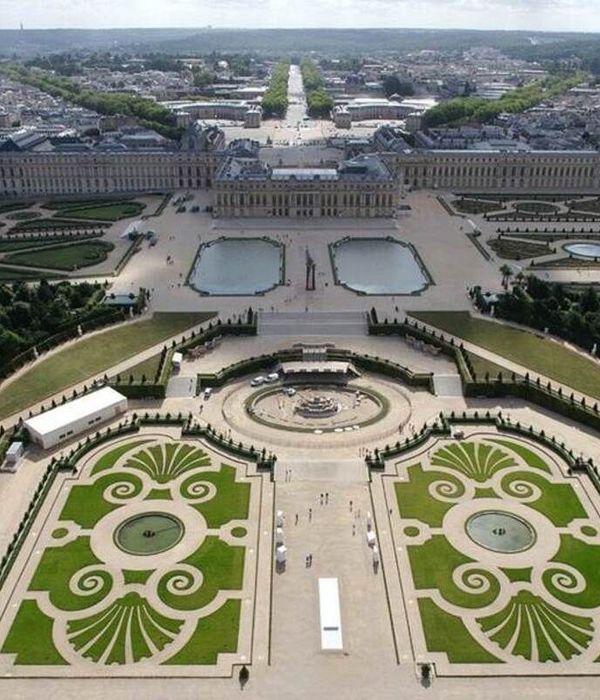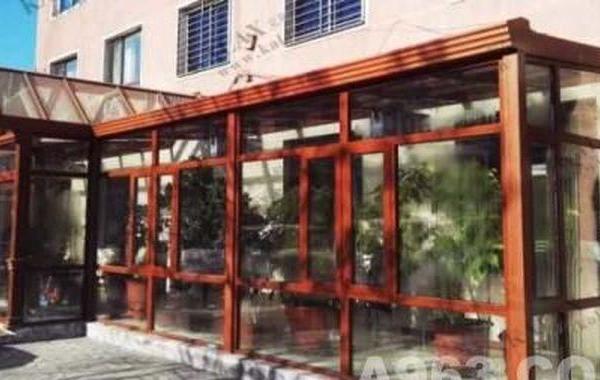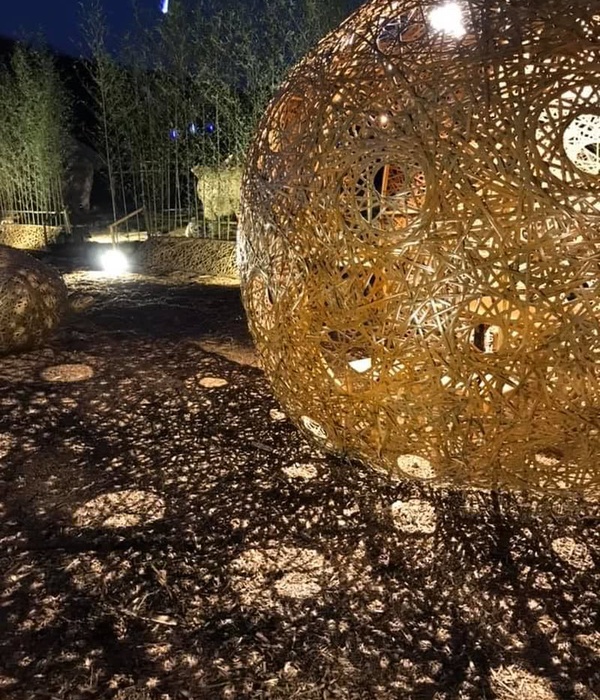大约十年前,设计师Bartosz Haduch偶然遇见了一种美丽的工业废料——具有无数不规则切口的灰色砂岩板。他多年来一直在寻找可以利用这种特殊材料的机会,最终在奥斯维辛遇到了合适的项目,灰色砂岩板在这里成为纪念公园的主旋律,象征着已经不复存在的犹太教堂的废墟和曾经纵横交错的多元文化社区的生命之路。
Almost a decade ago, I accidentally came across a beautiful industrial waste material – gray sandstone slabs with countless irregular cuts. For many years I was looking for an adequate design opportunity to take advantage of this singular material. Finally, I found the right project in the city of Oświęcim, where it became the leitmotiv of the Memorial Park, symbolizing the ruins of the now defunct Great Synagogue (1863-1939) and the paths of life of the multicultural community that were once criss-crossing in this place.
▼不同季节的纪念公园,Memorial Park in different seasons
新项目以多种形式回应了八十年前拆毁的教堂。狭窄的路缘石勾勒出前教堂的轮廓,将公园内的区域与周围茂密的绿植隔开。该区域面向Soła河堤岸的景观。公园中的主要元素是40块灰色砂岩板马赛克。它们不规则的排列方式呼应了前犹太教堂的遗迹,尤其是教堂地面采用类似的石材制成。独特的石板形成了通往其他元素的路径,分别是展示犹太教堂历史的户外展示模块、具有历史地面碎片的“井道”、浅水池、考登钢长椅和吊灯。这些元素的尺寸、形状和颜色不仅与犹太传统有关,而且具有普遍的象征意义,具有不同宗教和文化背景的人们都可以理解。新的空间具有开放性,允许不同的使用、纪念和理解方式。
▼分析图,diagram
▼俯视公园,overlooking the park
References to the temple demolished 80 years ago take on various forms in the new project. The outline of the former synagogue is marked by a narrow curb, separating the interior of the park from the dense greenery surrounding it. The new square opens up to the picturesque panorama of the embankments of the Soła River. The main element of the park’s arrangement is a mosaic of forty gray sandstone slabs. Their irregular arrangement echoes the remains of the former synagogue (particularly its floor, made of similar stone material). Individual slabs form paths leading to other elements of the park: an outdoor exhibition module presenting the history of the synagogue, a “well” with historical floor, a shallow water pond, Corten benches and a chandelier. Dimensions, shapes and colours of these new forms are all associated not only with Jewish tradition, but also with universal symbolism, legible for different confessions and cultures. This new space has an open character allowing for different ways of using, commemorating and interpreting.
▼40块灰色砂岩板马赛克,forty gray sandstone slabs
▼浅水池,the shallow water pond
▼考登钢长椅与户外展展示模块,Corten benches and the outdoor exhibition module
▼近景,closer view
“生命之路”通过独特的材料方案诠释了其主题思想。120 x 220厘米的灰色砂岩板上具有无数条深浅不一的条纹装饰,这些刻在石材上的线条创造出独特的“浮雕”,其外观随着阳光的角度和强度或雨雪天气而改变。有趣的是这种几何图案并不是建筑师利用最新技术的产物,而是完全偶然地创造出来的。这些大石板在采石场通常用作切割小石板的基座,从来没有人想过将它们用于建造。这些被归为工业废料的石板在奥斯维辛“复活”,表现出对过度开采自然资源的反对。
▼砂岩板手稿,manuscripts of sandstone slabs
▼纵横交错的切割石线,criss-crossing cut-in-stone lines
The illustration of the “paths of life” title idea manifests itself mainly in the form of a unique material solution. The 120 x 220 cm gray sandstone slabs are decorated with “frieze” made up of countless grooves of varying depths. These cut-in-stone lines create a kind of singular “relief” that changes its appearance depending on the angle of sunlight and its intensity, or atmospheric conditions – rain, snow etc. Interestingly, this geometric pattern does not result from the work of architects using latest technologies, but was created quite by accident. In the quarry these large slabs were used as bases for cutting smaller formats and no one had ever come up with the idea of using them in construction. Classified as industrial waste, they were reused and “brought back to life” in the city of Oświęcim – as a gesture of opposition to excessive exploitation of natural resources.
▼刻在石材上的线条创造出独特的“浮雕”,the cut-in-stone lines creating a kind of singular “relief”
纵横交错的切割石线也具有象征意义,它们没有明确的开始或结束,似乎正在走向无限。密集的线网如同人类的生活轨迹,时而相交而过,时而连在一起。看似抽象的马赛克还可以看做已经消失的战前城市布局,包括街道、人行路和建筑物。这段“石刻”的奥斯维辛历史、大犹太教堂及其被摧毁后留下的废墟保存了过去的记忆,向未来发出警告,同时美妙地庆祝当下。谁知道几百年后这里会不会成为神秘的考古遗址?毕竟,人类在几个世纪以来一直从石头上不朽的插图和文字中了解古代。在遥远的将来,人们又会如何解读纪念公园中四十块石板上隐藏的信息呢?
The criss-crossing cut-in-stone lines also take on a symbolic dimension. Without any clear beginning or end, they seem to be heading towards infinity. This dense network of lines evokes the paths of human life, that sometimes just intersect, and at other times connect to go on together. A seemingly abstract mosaic may also resemble the now defunct urban layout of a pre-war city – its streets, pavements and buildings. This “cut-in-stone” history of Oświęcim, the Great Synagogue and the ruins remaining after its destruction aims at preserving the memory of the past, with a warning message for the future, at the same time beautifully celebrating the present. Who knows, maybe after a few hundred years time, this place will become a mysterious archaeological site? After all, throughout centuries, humanity has been learning about ancient times from illustrations and texts immortalized in stone. I often wonder how will be interpreted in the distant future the message hidden in forty pieces of the Memorial Park?
▼公园冬景,the park in the winter
▼轴测图,axonometry
▼总平面图,master plan
▼平面图,plan
The Great Synagogue Memorial Park in Oświęcim
Authors: NArchitekTURA / Bartosz Haduch, Łukasz Marjański
Collaboration: Imaginga Studio / Magdalena Poprawska
Landscape architecture: NArchitekTURA / Bartosz Haduch
Structural engineer: Maria Koczur
Electrical design: Robert Haponik
Client: Auschwitz Jewish Center
Design: 2018-2019
Realization: 2019-2020
{{item.text_origin}}












